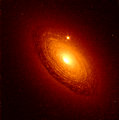astro.wikisort.org - Galaxy
NGC 1161 is a lenticular galaxy approximately 90 million light-years away from Earth in the constellation of Perseus.[3] It was discovered, along with NGC 1160, by English astronomer William Herschel on October 7, 1784.[4]
| NGC 1161 | |
|---|---|
 NGC 1161 (SDSS) | |
| Observation data (J2000.0 epoch) | |
| Constellation | Perseus |
| Right ascension | 03h 01m 14.10s [1] |
| Declination | +44° 53′ 50.00″ [1] |
| Redshift | 0.006518 [1] |
| Helio radial velocity | 1954 ± 23 km/s [1] |
| Distance | 90 Mly |
| Apparent magnitude (V) | 11.10 [2] |
| Apparent magnitude (B) | 12.10 [2] |
| Characteristics | |
| Type | S0 [1] |
| Apparent size (V) | 2.8 x 2.0 [1] |
| Other designations | |
| PGC 11404, MCG +07-07-015, UGC 2474 | |
NGC 1161 is classified as a Type 1.9 Seyfert galaxy.[5] It forms a visual pair with the galaxy NGC 1160. Both galaxies are located between the Local and Perseus superclusters in the Perseus Cloud close to the centre of the Local Void.[6]
Image gallery
 NGC 1161 (NASA/ESA HST)
NGC 1161 (NASA/ESA HST) NGC 1161 (NASA/ESA HST)
NGC 1161 (NASA/ESA HST)- NGC 1161 by 2MASS
See also
References
- "NASA/IPAC Extragalactic Database". ned.ipac.caltech.edu. Retrieved March 3, 2019.
- "Revised NGC Data for NGC 1161". spider.seds.org. Retrieved March 3, 2019.
- "NGC 1161". Retrieved March 3, 2019.
- "Data for NGC 1161". www.astronomy-mall.com. Retrieved March 3, 2019.
- Filho, Mercedes E.; Barthel, Peter D.; Ho, Luis C. (2006). "A Radio Census of Nuclear Activity in Nearby Galaxies". Astronomy & Astrophysics. 451 (1): 12. arXiv:astro-ph/0601080. Bibcode:2006A&A...451...71F. doi:10.1051/0004-6361:20054510. S2CID 16640767.
- Gregory, Stephen A.; Thompson, Laird A.; Tifft, William G. (1981). "The Perseus Superclaster". The Astrophysical Journal. 243: 416. Bibcode:1981ApJ...243..411G. doi:10.1086/158608.
External links
Wikimedia Commons has media related to NGC 1161.
- NGC 1161 on WikiSky: DSS2, SDSS, GALEX, IRAS, Hydrogen α, X-Ray, Astrophoto, Sky Map, Articles and images
- SEDS
На других языках
[de] NGC 1161
NGC 1161 ist eine Linsenförmige Galaxie mit aktivem Galaxienkern vom Hubble-Typ S0 im Sternbild Perseus am Nordsternhimmel. Sie ist schätzungsweise 93 Millionen Lichtjahre von der Milchstraße entfernt und hat einen Durchmesser von etwa 73.000 Lichtjahren. Gemeinsam mit NGC 1160 bildet sie das isoliert gelegene Galaxienpaar KPG 86. Im selben Himmelsareal befinden sich u. a. die Galaxien IC 274 und IC 275.- [en] NGC 1161
[ru] NGC 1161
NGC 1161 (другие обозначения — UGC 2474, MCG 7-7-15, ZWG 540.26, KCPG 86B, IRAS02579+4442, PGC 11404) — линзообразная галактика (S0) в созвездии Персей. Открыта совместно с галактикой NGC 1160 английским астрономом Уильямом Гершелем 7 октября 1784 года[3]. NGC 1161 образует визуальную пару с галактикой NGC 1160. Обе галактики находятся между Местным сверхскоплением галактик и сверхскоплением Персея-Рыб вблизи центра Местного войда[4]. Описание Дрейера: «тусклый, довольно маленький, немного вытянутый объект, более яркий в середине»[5].Текст в блоке "Читать" взят с сайта "Википедия" и доступен по лицензии Creative Commons Attribution-ShareAlike; в отдельных случаях могут действовать дополнительные условия.
Другой контент может иметь иную лицензию. Перед использованием материалов сайта WikiSort.org внимательно изучите правила лицензирования конкретных элементов наполнения сайта.
Другой контент может иметь иную лицензию. Перед использованием материалов сайта WikiSort.org внимательно изучите правила лицензирования конкретных элементов наполнения сайта.
2019-2025
WikiSort.org - проект по пересортировке и дополнению контента Википедии
WikiSort.org - проект по пересортировке и дополнению контента Википедии


